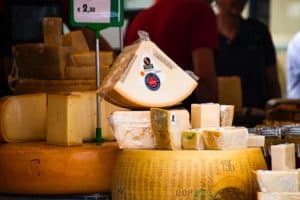Hey there, fellow food enthusiasts! Inspired by a cherished stop on our Roman Food Tour, where our wonderful explorers get to enjoy delightful cheese and wine pairings, we couldn’t help but feel that we needed to create a guide to help you master this culinary artistry.
While exploring the historical center of Rome on our roman food tour, you’ll indulge in freshly prepared pizzas, homemade pastas, roman pasta, and artisanal gelato. Among the highlights of your journey, expect a magical encounter with Italian cheeses that are expertly paired with exquisite wines.
In this post, we’re going to unravel the secrets behind successful cheese and wine pairings. Whether you’re a seasoned connoisseur or a curious beginner, eating in Rome on a budget by the Colosseum or creating memories at home, this guide will help you with the knowledge and confidence to embark on your own culinary adventures. From understanding the fundamentals to creating your own harmonious combinations, we’re exploring the world of textures, aromas, and unforgettable taste experiences.
Understanding the Basics
Before we get into the world of cheese and wine harmony, let’s cover the basics. Think of these pairings as a dynamic duo where balance and enhancement are key. Consider these four factors:
- Complementary Pairings: Just like a well-matched conversation, the flavors of cheese and wine should complement, not overpower each other. An aged Gouda’s nutty notes sync beautifully with the sweetness of Gewürztraminer, while the creaminess of Brie contrasts elegantly with Chardonnay’s acidity. These pairings give both the cheese and wine their moment to shine, crafting a sensory journey.
- Matching Intensity: The magic of pairing lies in finding the right balance of intensity between the cheese and wine. Aged cheeses like Parmigiano-Reggiano thrive alongside bold wines like Cabernet Sauvignon, where their robust flavors intertwine. On the other hand, delicate cheeses harmonize gracefully with lighter wines such as Sauvignon Blanc, allowing their subtleties to shine. This balance ensures a harmonious duet that celebrates both the cheese and the wine.
- Texture Dynamics: Texture matters. Creamy cheeses, like Brie or Camembert, share a delightful affinity with wines boasting a velvety texture, such as Chardonnay. The cheese’s lusciousness complements the wine’s smoothness, creating a luxurious combination. On the other hand, hard cheeses like Pecorino Romano find their counterpart in wines with structured tannins, like Cabernet Sauvignon. The interplay between the cheese’s firmness and the wine’s tannins results in a harmonious contrast.
- Balance in Acidity: Acidity is the harmonious thread that weaves cheese and wine together. Wines with vibrant acidity, like Sauvignon Blanc or Champagne, cleanse the palate when enjoyed with tangy cheeses like goat cheese or Feta. The wine’s acidity cuts through the richness of the cheese, refreshing the taste buds. Conversely, cheeses with elevated acidity, such as aged cheddar, find equilibrium with wines like Vermentino or Albariño. The shared acidity elevates both the cheese and the wine, accentuating their unique characteristics.
These basics will boost your confidence in crafting delightful flavor journeys. As you explore matching intensity, texture dynamics, and acidity balance, you’ll uncover the magic of cheese and wine partnerships.
Italian Cheese Varieties

Italian cheeses promise a wide range of flavors catering to every palate – from creamy and mild to bold and tangy. These cheeses are the perfect partners for wines, creating harmonious duets. Here’s a peek into the cheeses you might encounter on your run the closest local store, or during our roman food tour:
Parmigiano-Reggiano: Often hailed as the “King of Cheeses,” Parmigiano-Reggiano boasts nutty and savory notes. Its granular texture and intense umami make it a great match for full-bodied red wines like Chianti.
Pecorino Romano: A hard, salty sheep’s milk cheese, Pecorino Romano adds tanginess. Its robust character shines alongside red wines, especially those with earthy hints.
Mozzarella: Renowned for mild, milky taste and delicate texture, Mozzarella pairs seamlessly with lighter white wines, lending a refreshing contrast.
Gorgonzola: With blue veins and creamy texture, Gorgonzola offers a complex balance from tangy to sweet. It complements dessert wines splendidly.
Asiago: Both aged and fresh versions of Asiago play well. The aged variety shines with red wines, while the milder form harmonizes with crisp whites.
Fontina: Known for its melt-in-your-mouth creaminess, Fontina’s nutty notes find harmony with wines boasting herbal and floral hints.
Ricotta: Creamy and slightly sweet, ricotta is versatile for savory and sweet pairings. It complements wines with fruity, floral traits.
Provolone: Ranging from mild to piquant, Provolone adapts to various wine partners. Aged Provolone pairs with reds, younger ones elevate whites.
From the iconic Parmigiano-Reggiano to the delicate Mozzarella, Italian cheeses offer an incredible diversity of flavors and textures. Each cheese has a unique story to tell, rooted in the regions and traditions that have crafted them for centuries.
Italian Wine Selections

Italian wines offer a captivating spectrum, from reds to whites and sparkling choices. They complement the richness of Italian cheeses beautifully. Let’s explore the distinct characteristics of each wine type and their harmonious pairings.
Red Wines: Italian reds span bold to nuanced. Rich options like Barolo and Chianti Classico bring deep berry notes and earthiness. These wines enhance aged cheeses. Lighter reds like Valpolicella dance with milder cheeses such as fresh mozzarella.
White Wines: Italian whites blend refreshing acidity and delicate aromas. Wines like Pinot Grigio and Vermentino invigorate with zesty citrus and floral scents. Paired with creamy cheeses like Ricotta or Burrata, they offer balanced and vibrant tasting experiences.
Sparkling Wines: Italian sparkling wines lend effervescence and elegance. Prosecco’s lively bubbles and crisp apple notes complement the creaminess of mascarpone or gorgonzola. Franciacorta or Trento DOC’s complexity elevates aged Parmigiano Reggiano to an enchanting crescendo.
In Rome, while you can certainly enjoy the classic wine selections mentioned earlier, you’ll also find a diversity of local and regional wines that beautifully align with the city’s culinary identity. These lesser-known gems add an element of surprise to your wine and cheese pairings, enriching your palate and creating an even more memorable gastronomic experience. So, as you explore the charming streets of Rome, don’t hesitate to venture beyond the familiar and embrace the diversity that Italian wine has to offer. After all, the beauty of pairing wine and cheese lies in the endless possibilities that each sip and bite can bring to your table.
Classic Pairings

Getting into the world of wine and cheese pairings, let’s explore timeless combinations gracing Italian tables for generations. These pairings are like old friends – comforting, familiar, yet always delightful in their well-balanced interaction of flavors.
Parmigiano-Reggiano with Lambrusco: The nutty, salty richness of Parmigiano-Reggiano meets the lively Lambrusco. Lambrusco’s effervescence and red fruit notes balance the cheese’s intensity.
Pecorino Romano with Chianti: The salty, tangy Pecorino Romano finds harmony with Chianti’s dry, fruity flavors. It’s a rustic partnership reflecting Italy’s charm.
Gorgonzola with Amarone: Gorgonzola’s creamy blue veins blend seamlessly with Amarone’s bold, complex notes. Rich berry flavors complement the cheese’s earthiness.
Asiago with Soave: Asiago’s buttery, nutty notes contrast with Soave’s crisp, citrusy profile. It’s a balance of elements uplifting each other.
Pecorino Toscano with Vernaccia di San Gimignano: Pecorino Toscano dances effortlessly with Vernaccia’s bright acidity. Zesty lemon and almond notes elevate the cheese’s tanginess.
Mozzarella di Bufala with Falanghina: Creamy Mozzarella di Bufala meets light, crisp Falanghina. Delicate floral and citrus aromas mirror the cheese’s freshness.
Robiola with Prosecco: Soft Robiola pairs with Prosecco’s effervescence, allowing delicate mushroom-like flavors to shine. It’s an elegant celebration.
Taleggio with Nebbiolo: Taleggio’s pungency complements Nebbiolo’s complex aromas. Roses, tar, and red fruits bring out the cheese’s bold personality.
Ricotta with Moscato d’Asti: Light, creamy Ricotta meets Moscato d’Asti’s floral, fruity charms. Sweet, effervescent notes balance the cheese’s mild sweetness.
Ready to share your passion for fromage and vino with friends and loved ones? Invite them for a roman food tour if you’d like the full experience, or challenge yourself to host your own party. Tailor the pairings to your guests’ preferences, introducing them to a variety of cheeses and wines. Present each pairing thoughtfully, offering context for the flavors they’ll experience. Set the ambiance with a cozy setting, soft lighting, and perhaps some Italian music. And at the end, if your guests still have some time for coffee, show them how to drink coffee like a real italian.
Trust your palate, follow your instincts, and don’t forget to have fun in the process. Whether staying safe with classic pairings or adventuring in your own combinations, remember that each pairing is a celebration of the art of gastronomy. Buon appetito!
Hungry for more Italian recipes? Check out Pollo con Pepperoni, a delightful traditional meat dish in Roman cuisine.
